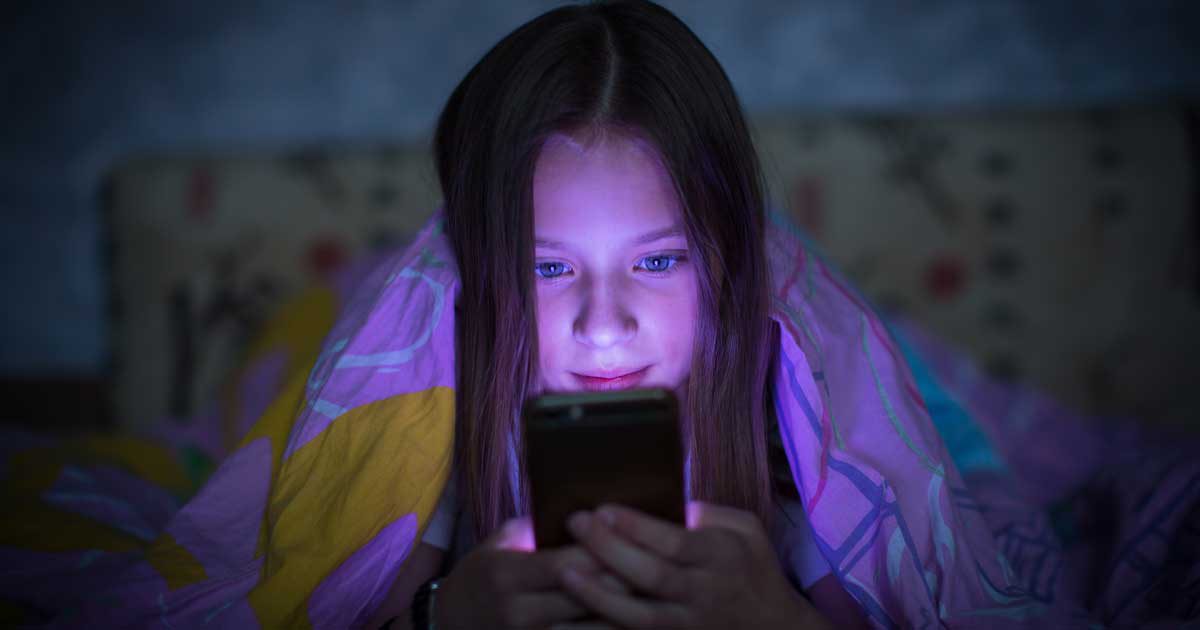
Our teens have been glued to their screens like never before. How can we help get the balance back? Leading adolescent psychologist Andrew Fuller offers some strategies for parents to gently support the process.
Imagine for a moment that we were doing a a hypnosis session. The imagery of the session absorbs your mind, you feel calm and safe. You are on a delightful inner journey. There may be challenges to encounter that absorb you and enchant you and you may be on a quest to find something important that has eluded you.
Imagine then, that someone rushes into the room, interrupting your reverie while demanding that you instantly come back to your usual state of consciousness immediately. I doubt you would feel very happy.
If you have ever had a hypnosis session, you may recall that the hypnotherapist eases you back into your usual state of consciousness gently. Often by slowly counting from five to one.
Screen time is trance time. After an extended period of intensive screen time, we need to gently ease and wean our teens.
Don’t start this if you are locked down
Do NOT try to wean your teen from their screens if you are in lockdown. The result will be sheer misery. Perhaps you already know this. Perhaps you have already tried (and failed). Perhaps you have already witnessed the mouth-frothed rage that ensues when a parent tries to enforce limits on locked down kids. (If you haven’t, count yourself lucky and read on to avoid for yourself a world of pain).
Common parenting ‘fails’
Common ‘fail’ No. 1
What parents try: Suggesting that your teen should go outside and play and get some fresh air and maybe, even do some of the one hour of recommended exercise per day.
Likely outcome: Death-glare. ‘You do know we have a pandemic going on? You are not sending me outside, you are sending me to my death.’
Common ‘fail’ No. 2
What parents try: Losing it! Turning the device off and removing it.
Likely outcome: Total ballistics. Threats of violence, self-harm and statements that life is no longer worth living. A full-blown tantrum that you haven’t seen the like of since they were four-year-old.
Common ‘fail’ No. 3
What parents try: You – kind, thoughtful parent that you are – decide to allow them to take full responsibility for their gaming.
Likely outcome: The vampire is in charge of the blood bank. The sounds of computer games wake you at 3am.
Common ‘fail’ No. 4
What parents try: You firmly decide to take matters in hand and require all devices to be in the kitchen on recharge overnight by 9pm.
Likely outcome: After three days and three nights of unremitting misery, squabbling and nagging, the new rule is consigned to the dustbin in an attempt to restore family relationships from their current high-alert, war settings.
Common ‘fail’ No. 5
What parents try: Suggesting their online friends are not ‘real’ friends and proposing the name of an old school friend they should catch up with.
Likely outcome: Other gamers are their only friends and besides the contact you suggested plays the game too.
Common ‘fail’ No. 6
What parents try: In a last ditch attempt you tell them they are wasting their life on gaming and should rise to their smarts and learning strengths.
Likely outcome: Games are where your teen feels accomplished and successful. They told you the game is essential to their confidence, mental health and self-esteem.
How games addict our kids
The dopamine ‘hits’ designed into computer games provide an intense and enchanting mixture of achievement and challenge. Even when things don’t work out well, such as being obliterated by being blasted out of existence by a group of malevolent cyborgs, there is always a chance to have other go. Failure is not considered. ‘Go again, go better’ is the common mantra of most gamers.

Let the weaning begin
So you’ve been watching your teen become more absorbed and reliant on computer games and less attentive to people, exercise and some of the finer, kinder values you hoped to impress upon them as a result of your fine parenting.
Attempts to rein in their compulsion to play games have been rebutted vigorously. At times, the beast has been off the leash.
Being without access to technology, brings painful feelings for teens. They report feeling lonely, upset or anxious.
If your teen is in the senior years of school your levels of concern have skyrocketed.
So let’s briefly introduce the RESOLVE model outlined in my book Tricky Behaviours.
The RESOLVE model is:
R espond with respect
E ngage
S eek understanding
O bserve feelings
L ower the tone
V alue add
E mpower
RESOLVE in more detail
R espond with respect
Aim to respond rather than react. If we react, we are being led by an upset teen. Responding involves leading and calming.
You may glean from the above examples that arriving into your teen’s room, hot under the collar and demanding immediate compliance with your wishes is not a strategy that will create ongoing change.
No doubt you will still need to implement sudden limits from time to time. If effective at all, these may create a temporary, sullen compliance but not change.
If you want to create real change, do not wait until you are angry to start it.
E ngage
Walk into their room as carefully as you would enter a battlefield (because you virtually are).
Enter without making a comment (knock first) place a chair and sit beside your teen as they play the game. Remain as silent as you can.
The things you definitely should not say include:
‘Haven’t you got homework to do?’
‘It’s time to switch off and go to sleep.’
‘Can you turn down the volume?’
Eighty per cent of communication is non-verbal. What you do is more important than what you say.
S eek understanding
As you sit watching them play, ask some questions about the game. Your aim is to gently bring your teen out of trance, not to conduct an interrogation.
Don’t talk all the time. The trance you are trying to alter is one of kill-or-be-killed, fight or flight and it is captivating.
If they appear frustrated or agitated with you, return to silence for at least five minutes before commenting again. Speak only in a calm voice.
O bserve feelings
In even the busiest shoot ‘em up game, there are bursts and lulls. Use the lulls to ask them how the game is going and what strategies are working. Some gamers will be proud of their accomplishments and will want to teach you about the game or share the level they have attained.
L ower the tone
Calming and re-orienting an avid gamer takes patience and strategy. Lowering the intensity of the trance involves being aware of the neurochemistry of gaming.
Two neurochemicals that we often need to lessen before we can get change:
Cortisol and Adrenaline
These are the stress chemicals. While gaming is exciting, it is also stressful.
These can cause people to have a steely focus without necessarily being able to think their way towards a solution. These neuro-chemicals can also make them unbending and rigid in their actions.
If your teen has been playing for a prolonged period it is likely that they are dehydrated and cranky due to low blood sugar.
Bring them a drink and a snack. Don’t ask them what they want (remember they are in a trance). Just bring them.
This will help you to shift towards calmness. Some ways include:
- Increasing certainty, especially that you are not going to ‘force’ them off the game suddenly
- Being beside someone
- Calm and attentive listening
- Reassurance that their gaming is being taken seriously. Remember for kids, play is work.
Two neurochemicals that we want to increase are:
Dopamine and Serotonin
- Once they are less agitated we can increase these by:
- Giving positive feedback
- Emphasising points of agreement
- Giving choices e.g. do you want to do some of the study now or in a bit. (They will almost always, opt for later). Okay, would half an hour seem reasonable to you?
If you can, sit with them and learn the game for half an hour. If you can’t, at least pop into the room once during that time (deliver more food and drinks if need be).
V alue add
Gaming is a great way to feel successful and is also a way of avoiding areas (such as study) where failure is a risk.
This means we need to acknowledge the allure of the game while also providing more support in areas that are seen as threatening.
Ask, ‘What would you like me to do?’ or ‘How can I help you?’, ‘Is there something I can do that will help you to start?’
E mpower
Gaming is part of the mix of teen life, as is social media. The important word here is ‘mix’.
Just as you can’t survive on only one food type, we all need a range of different activities to feel happy. At a non-gaming time, try to have that conversation with you teen i.e. What are the important activities for you? What is the best balance?
Take it slowly
Just as weaning a baby takes time, lessening reliance on gaming will take time.
Good luck at starting this process.
©Andrew Fuller
Like this post? Please share using the buttons on this page.
This is one of two companion articles to Andrew’s webinar for The Parents Website on 12 October 2020.
You can read the the first article, How to get your child’s learning mojo back after this ‘year of fear’.
About Andrew Fuller
Andrew is a clinical psychologist specialising in the wellbeing of young people and their families.
Stay in touch with Andrew on Facebook, on LinkedIn, through his website and on the My Learning Strengths website
More tips about how to maximise your success can be found at:
Andrew’s websites
www.andrewfuller.com.au
www.mylearningstrengths.com (45,000 young people in the past year discovered their learning strengths and found how to increase success and motivation).
Books for parents
Tricky Conversations
Tricky Teens and Emerging Adults: A survival guide for parents
Unlocking Your Child’s Genius: How to discover and encourage your child’s natural talents
Books for teachers
Guerilla Tactics for Teachers: The Essential Classroom Management Guide
Work Smarter, Not Harder: Study skills for students who dislike homework
Tricky Conversations: How to have less conflict and more peace in your life
Neurodevelopmental Differentiation: Optimising Brain Systems to Maximise Learning



